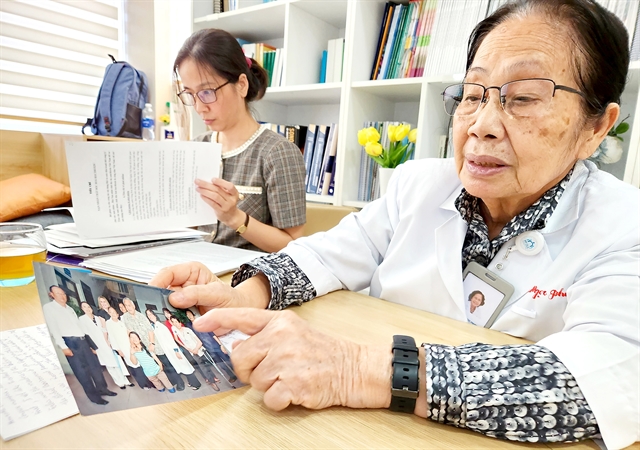Woman spends half-century journey to seek justice for Agent Orange victims
Society – Economy - Ngày đăng : 08:24, 25/11/2024
 |
| Professor Nguyễn Thị Ngọc Phượng shares about her journey to seek justice for Agent Orange victims.— VNA/VNS Photo Đinh Hằng |
HÀ NỘI — Professor Nguyễn Thị Ngọc Phượng was awarded the Ramon Magsaysay Prize, often referred to as the Asian equivalent of the Nobel Prize, last Saturday in the Philippines.
She is one of five recipients of the prestigious honour for the year.
Professor and doctor Nguyễn Thị Ngọc Phượng was recognised for her tireless efforts over nearly five decades in seeking justice for the victims of Agent Orange and dioxin poisoning.
Born in 1944 in HCM City, Phượng chose to pursue a career in medicine, specialising in obstetrics and gynaecology.
Her turning point came in 1966, while she was still an intern.
“I was assisting with a childbirth at Từ Dũ Hospital when I was horrified to see a new-born without a skull, its body covered in hair, resembling a monkey,” she said.
From then on, she encountered more and more cases of new-borns with various congenital defects, including anencephaly, missing eyes, noses and limbs.
Reflecting on the early days, she said: “To truly understand the agony of mothers, who give birth to such children, one must witness it firsthand.
"Some cannot accept the horrific reality and go mad, some suffer from depression, while others are abandoned by their families—such suffering is unimaginable.”
After several such cases, she suggested Từ Dũ Hospital to preserve the malformed foetuses for research.
During her investigation, she came across a document from the United States’ National Academy of Sciences, which helped her link the birth defects to the toxic chemicals used by the US military in Việt Nam.
In 1976, after uncovering the “terrible secret,” she embarked on a long journey to gather scientific evidence proving that Agent Orange/dioxin was the cause of the birth defects and various cancers.
To gather the evidence, she and her colleagues conducted several surveys in the Mekong Delta, an area previously targeted by the US military for chemical defoliation.
Investigations in Bến Tre and Cà Mau in 1982 revealed that in the regions, the rate of miscarriages, stillbirths and congenital disabilities were significantly higher than in other areas.
Using the data, she presented three reports on the long-term effects of herbicides and defoliants at an international conference attended by representatives from 22 countries in 1983.
In 1987, she again presented the findings on the impact of dioxin at a conference in the United States on the toxin, with the paper subsequently published in a British scientific journal in 1989.
Throughout her journey to seek justice for Agent Orange victims, Phượng wept many times witnessing the pain of the victims.
She became even more determined to prove that the suffering endured by the people was real and must be recognised and compensated.
Unyielding
From 2008 onwards, as a scientist and Vice President of the Việt Nam Association for Victims of Agent Orange/dioxin Foundation, she participated in several hearings of the US House of Representatives on the issue.
During the hearings, she called on the US Congress and chemical companies to take responsibility for compensating the more than three million Vietnamese victims of Agent Orange.
After that, US parties began cooperating to remediate the environment and address the aftermath of Agent Orange contamination in Việt Nam.
In parallel, she worked tirelessly to bring images of malformed foetuses and disabled children to the international community, seeking global support for the victims’ fight for justice.
One of the most unforgettable moments in her search for evidence was her encounter with the conjoined twins.
She brought the twins to Từ Dũ Hospital, where they were cared for and underwent a successful separation surgery in 1988.
Later, as Director of Từ Dũ Hospital, she established the Hòa Bình Village - a sanctuary for hundreds of disabled children abandoned by their families.
At the village, many disabled children were able to learn a trade, and some even went on to start their own families, becoming independent.
In late August, after receiving the news of her Ramon Magsaysay Prize, she was truly surprised.
“At this moment, I think of the victims of Agent Orange. I remember the days I spent working with my colleagues, relentlessly seeking evidence of the effects of dioxin in Việt Nam.
"That nearly 50-year journey has been incredibly difficult, and now, I am so happy to see my efforts recognised by the international community.”
She said: “We may not have succeeded legally, but we have gained the support of global public opinion, from those who love peace and we will not give up.”
Alongside her work for the victims of Agent Orange, she is also known for her contributions to the field of Vietnamese medicine.
She was a pioneer in bringing in vitro fertilisation (IVF) to Việt Nam, becoming the fairy godmother for families struggling with infertility.
She also founded the 'Midwife in the Village' programme, which helped reduce maternal mortality and obstetric complications in remote areas across the country.
In recent years, she launched the 'Nurturing Happiness' programme, assisting infertile couples from disadvantaged backgrounds in their journey to parenthood.
At the age of 80, she still continues to work with the motto: “While my blood is still warm, I will continue to do useful things.” — VNS
